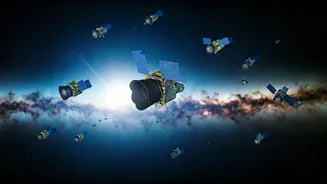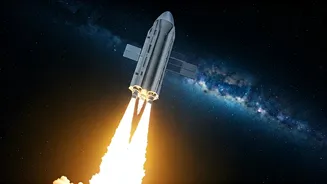CSF Welcomes New
The Commercial Space Federation (CSF) announced the addition of new associate members. This signifies an ongoing expansion of the commercial space industry.
The CSF's growth mirrors the dynamic evolution within the sector, where various companies are now vying for prominence. This inclusivity in the CSF fosters a collaborative environment, bringing together both emerging and established entities to jointly navigate the intricacies and opportunities found in the space industry. This welcome of new members suggests a concerted drive for shared objectives such as enhancing innovation and promoting cooperative relationships that will push the boundaries of space exploration. This also signals a strengthening of the private sector's role in shaping the future of space activities.
Space Leaders Collaborate
SpaceNews and Johns Hopkins University (JHU) organized a meeting to convene space leaders. The main objective of the event was to foster closer collaboration between commercial entities and government agencies. Discussions at the event undoubtedly covered topics related to how these two distinct sectors might cooperate in the future, including issues such as technology transfer and the sharing of resources. Such dialogue could lead to improvements in areas like space exploration, technology development, and national security, while also establishing streamlined strategies for future collaborative missions. The success of space ventures in the future could rest on such coordinated interactions, as both government and commercial entities pool their resources and knowledge for mutual benefit, and the advancement of space exploration.
SatBat's Revolutionary Launch
ESI Motion unveiled its innovative “SatBat,” a space-rated battery set designed to revamp power systems in low Earth orbit. This revolutionary battery technology represents a huge step forward in the capacity and reliability of satellite power systems. The introduction of the SatBat underscores the critical need for advanced and efficient power solutions. This is vital to handle the increasing energy needs of satellites. The SatBat will support longer mission lifespans and greater operational capabilities. This also highlights the continuous drive for technological innovation in the space industry. The launch of the SatBat not only improves satellite efficiency, but also contributes to the sustainability of space activities.
SES's New Contract
SES has bolstered its involvement in the busiest servicing pipeline. This was accomplished via a contract with Infinite Orbits. This move reinforces the significance of SES in the ongoing lifecycle of geostationary (GEO) satellites. This contract is a clear sign of SES's dedication to boosting the lifespan of its satellites, offering essential services, and cutting down on space debris. The GEO servicing pipeline has become the leading edge for satellite operators, offering cost-effective and sustainable solutions. By investing in life extension technologies, SES shows its strategic focus on maintaining a competitive edge and meeting the demands of an expanding global market.
Busy Year For Extenders
The coming year anticipates significant activities in the satellite life extension sector. As satellites age, the demand for life extension services grows. Satellite life extension solutions are becoming increasingly critical for operators. This includes extending the usability of existing satellites and delaying the need for costly replacements. Various companies are now offering advanced services and technologies to prolong the operational life of satellites. This ensures that valuable assets in orbit continue to function. The growth of this market is driven by economic and environmental concerns, as it minimizes space debris and boosts the efficiency of space infrastructure.
MEV Fleet's Intelsat Missions
The Mission Extension Vehicle (MEV) fleet continues its success, building upon early missions with Intelsat. The MEV's early involvement with Intelsat shows its ability to successfully extend the lifespan of satellites. This increases the value of these assets. The ongoing achievements of the MEV fleet demonstrate the feasibility of in-space servicing and its positive impact on the industry. The MEV fleet has proven to be a reliable and cost-effective approach for satellite operators. The fleet can provide critical support in managing space assets and achieving operational goals. The continued success and expansion of the MEV fleet signal the evolving nature of in-space infrastructure and support services.













